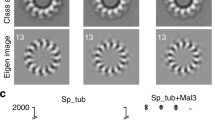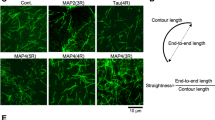Summary
Microtubule-associated proteins (MAPS) were separated from tubulin with several different methods. The ability of the isolated MAPs to reinduce assembly of phosphocellulose purified tubulin differed markedly between the different methods. MAPs isolated by addition of 0.35 M NaCl to taxol-stabilized microtubules stimulated tubulin assembly most effectively, while addition of 0.6M NaCl produced MAPs with a substantially lower ability to stimulate tubulin assembly. The second best preparation was achieved with phosphocellulose chromatographic separation of MAPs with 0.6 M NaCl elution.
The addition of estramustine phosphate to microtubules reconstituted of MAPS prepared by 0.35 M NaCl or phosphocellulose chromatography, induced less disassembly than for microtubules assembled from unseparated proteins, and was almost without effect on microtubules reconstituted from MAPs prepared by taxol and 0.6 M NaCl. Estramustine phosphate binds to the tubulin binding part of the MAPs, and the results do therefore indicate that the MAPs are altered by the separation methods. Since the MAPs are regarded as highly stable molecules, one probable alteration could be aggregation of the MAPs, as also indicated by the results. The purified tubulin itself seemed not to be affected by the phosphocellulose purification, since the microtubule proteins were unchanged by the low buffer strenght used during the cromatography. However, the assembly competence after a prolonged incubation of the microtubule proteins at 4° C was dependent on intact bindings between the tubulin and MAPs.
Similar content being viewed by others
Abbreviations
- Pipes:
-
1,4-Piperazinediethanesulfonic acid
- EDTA:
-
Ethylenedinitrilo Tetraacetic Acid
- MAPs:
-
Microtubule-Associated Proteins
- SDS-PAGE:
-
SDS-Polyacrylamide Gel Electrophoresis
References
Dustin P: Microtubules, Springer Verlag, Berlin, Heidelberg, Tokyo, 1984
Drubin DG, Kirschner MW: Tau protein function in living cells. J Cell Biol 103: 2739–2746, 1986
Sloboda RD, Rosenbaum JL: Decoration and stabilization of intact, smooth-walled microtubules with microtubule-associated proteins. Biochemistry 18: 48–55, 1979
Weingarten M, Lockwood A, Hwo S, Kirschner MW: A protein factor essential for microtubule assembly. Proc Natl Acad Sci USA 72: 1858–1862, 1975
Murphy DB, Borisy GG: Association of high-molecular-weight proteins with microtubules and their role in microtubule assembly in vitro. Proc Natl Acad Sci USA 72: 2696–2700, 1975
Vallee RB: A taxol-dependent procedure for the isolation of microtubules and microtubule-associated proteins (MAPs). J Cell Biol 92: 435–442, 1982
Carlier M-F, Simon C, Pantaloni D: Polymorphism of tubulin oligomers in the presence of microtubule-associated proteins. Implications in microtubule assembly. Biochemistry 23: 1582–1590, 1984
Maccioni RB, Serrano L, Avila J: Structural and functional domains of tubulin. BioEssays 2: 165–169, 1985
Bordas J, Mandelkow E-M, Mandelkow E: Stages of tubulin assembly and disassembly studied by time-resolved synchrotron X-ray scattering. J Mol Biol 164: 89–135, 1983
Berkowitz SA, Katagiri J, Binder HK, Williams RC Jr: Separation and characterization of microtubule proteins from calf brain. Biochemistry 16: 5610–5617, 1977
Vallee RB, Borisy GG: The non-tubulin component in microtubule protein oligomers. J Biol Chem 253: 2834–2845, 1978
Howard WD, Timasheff SN: GDP state of tubulin: stability of tubulin rings. Biochemistry 25: 8292–8300, 1986
Weisenberg RC: The role of ring aggregates and other structures in the assembly of microtubules. J Supramol Struct 2: 451–465, 1974
Olmsted JB, Borisy GG: Ionic and nucleotide requirements for microtubule polymerisation in vitro. Biochemistry 14: 2996–3005, 1975
Kanje M, Deinum J, Wallin M, Ekström P, Edström A, Hartley-Asp B: Effect of estramustine phosphate on the assembly of isolated bovine microtubules and fast axonal transport in the frog sciatic nerve. Cancer Res 45: 2234–2239, 1985
Wallin M, Deinum J, Fridén B: Interaction of estramustine phosphate with microtubule-associated proteins. FEBS Lett 179: 289–293, 1985
Fridén B, Wallin M, Deinum J, Prasad V, Luduena R: Effect of estramustine phosphate on the assembly of trypsin-treated microtubules and microtubules reconstituted from purified tubulin with either tau, MAP2 or the tubulin-binding fragment of MAP2. Arch Biochem Biophys 257: 123–130, 1987
Deinum J, Sörskog L, Wallin M: Effect of cibacron blue on tubulin assembly in the absence and presence of microtubule-associated proteins. Biochim Biophys Acta 719: 370–376, 1982
Lowry OH, Rosenbrough NJ, Farr A, Randall RJ: Protein measurements with Folin phenol reagent. J Biol Chem 193: 265–275, 1951
Weisenberg RW, Timasheff SN: Aggregation of microtubule subunit proteins. Effects of divalent cations, colchicine and vinblastine. Biochemistry 9: 4110–4116, 1970
Herzog W, Weber K: Fractionation of brain microtubule-associated proteins. Isolation of two different proteins which stimulate tubulin polymerization in vitro. Eur J Biochem 92: 1–8, 1978
Laemmli UK: Cleavage of structural proteins during the assembly of the head of bacteriophage T4. Nature (London) 227: 680–685, 1970
Fridén B, Nordh J, Wallin M, Deinum J, Nordén B: Effects of proteolysis of the extending parts of the high-molecular-weight microtubule-associated proteins on interactions between microtubules. Biochim Biophys Acta 955: 135–142, 1988
Vallee RB: On the use of heat stability as a criterion for the identification of microtubule-associated proteins (MAPs). Biochem Biophys Res Com 133: 128–133, 1985
Prus K, Wallin M: The ATPase activity in brain microtubule preparations is membrane-associated. Histochem 78: 181–193, 1983
Montejo de Garcini E, Avila J: In vitro conditions for the self-polymerisation of the microtubule-associated protein, tau factor. J Biochem 102: 1415–1421, 1987
Foisner R, Wiche G: Promotion of MAP/MAP interaction by taxol. J Ultrastructure Res 93: 33–41, 1985
Lewis SA, Ivanov IE, Gwo-Hwa L, Cowan NJ: Organization of microtubules in dendrites and axons is determined by a short hydrofobic zipper in microtubule-associ ated proteins MAP2 and tau. Nature (London) 342: 498–505, 1989
Mandelkow E, Mandelkow E-M: Tubulin, microtubules, and oligomers, molecular structure and implications for assembly. In: FD Warner and JR McIntosh (eds). Cell Movement. Alan R. Liss, Inc. New York. 1989, pp 23–45.
Author information
Authors and Affiliations
Rights and permissions
About this article
Cite this article
Fridén, B., Wallin, M. Dependency of microtubule-associated proteins (MAPS) for tubulin stability and assembly; use of estramustine phosphate in the study of microtubules. Mol Cell Biochem 105, 149–158 (1991). https://doi.org/10.1007/BF00227754
Received:
Accepted:
Issue Date:
DOI: https://doi.org/10.1007/BF00227754




